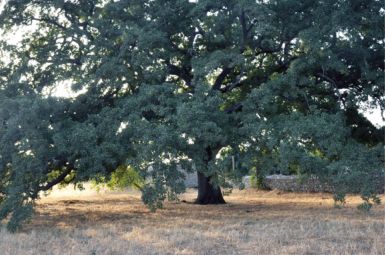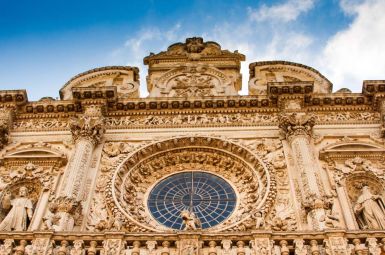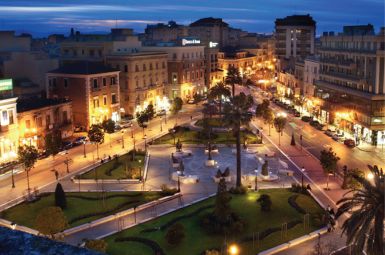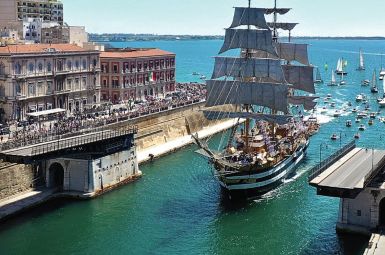
Conca dei Marini
Il Borgo di Conca dei Marini
Conca dei Marini: L’Eterna Emozione della Costiera Amalfitana
Conca dei Marini non è semplicemente un paese; è un’ode al Mediterraneo, un autentico rifugio dove la storia marinara si fonde con la bellezza geologica in un connubio dichiarato Patrimonio dell’Umanità UNESCO fin dal 1997. Incorniciata tra i picchi rocciosi e l’azzurro profondo, questa perla della Costiera Amalfitana rappresenta il lusso discreto e la tradizione inalterata. Il suo stesso nome evoca un legame indissolubile con il mare: l’antica vocazione marittima, che un tempo la vedeva base navale della Repubblica Amalfitana e protagonista dei commerci con ben ventisette galeoni, risuona ancora oggi nel silenzio delle sue calette.Tesori Segreti: L’Esperienza da Vivere
La vera essenza di Conca dei Marini si rivela a chi sa perdersi tra le sue “scalinatelle” adornate di profumi mediterranei, lontane dalla frenesia delle rotte più battute.1. La Grotta dello Smeraldo: Il Tempio Marino
Scoperta nel 1932, la Grotta dello Smeraldo è l’attrazione simbolo. Questa insenatura carsica si trasforma in una cattedrale sottomarina quando la luce filtra attraverso una fenditura, illuminando l’acqua con un verde smeraldo irreale. Un’esperienza sensoriale indimenticabile, arricchita dalla presenza di suggestive stalattiti, stalagmiti e un presepe subacqueo in ceramica.2. Il Monastero Santa Rosa: Storia e Ospitalità di Lusso
Eretto su uno sperone di roccia nel 1681, l’ex Conservatorio di Santa Rosa da Lima domina il Capo di Conca con una vista mozzafiato. Oggi trasformato in un hotel a cinque stelle di fama mondiale, questo luogo sacro è legato alla nascita della celebre Sfogliatella Santa Rosa, un capolavoro della pasticceria campana ideato proprio dalle suore di clausura.3. Il Faro e la Torre Saracena
A guardia del promontorio, troneggia fiera la Torre Bianca o Torre Saracena, parte integrante del sistema difensivo voluto dal Viceré di Napoli per proteggere la costa dalle incursioni corsare. Questo baluardo storico offre uno dei belvedere più suggestivi e romantici sull’intera baia.Un Rifugio per l’Élite
Fin dagli anni d’oro della Dolce Vita, Conca dei Marini ha attratto un jet set internazionale in cerca di autenticità e riservatezza. Personalità come Jacqueline Kennedy Onassis e Sofia Loren hanno scelto la sua baia come rifugio esclusivo, cementando la sua reputazione come meta per chi desidera l’eccellenza, lontano dai riflettori. A Conca dei Marini, la bellezza non è solo da ammirare, ma da assaporare in ogni scalino, in ogni scorcio e in ogni leggenda tramandata dai suoi fieri e riservati abitanti.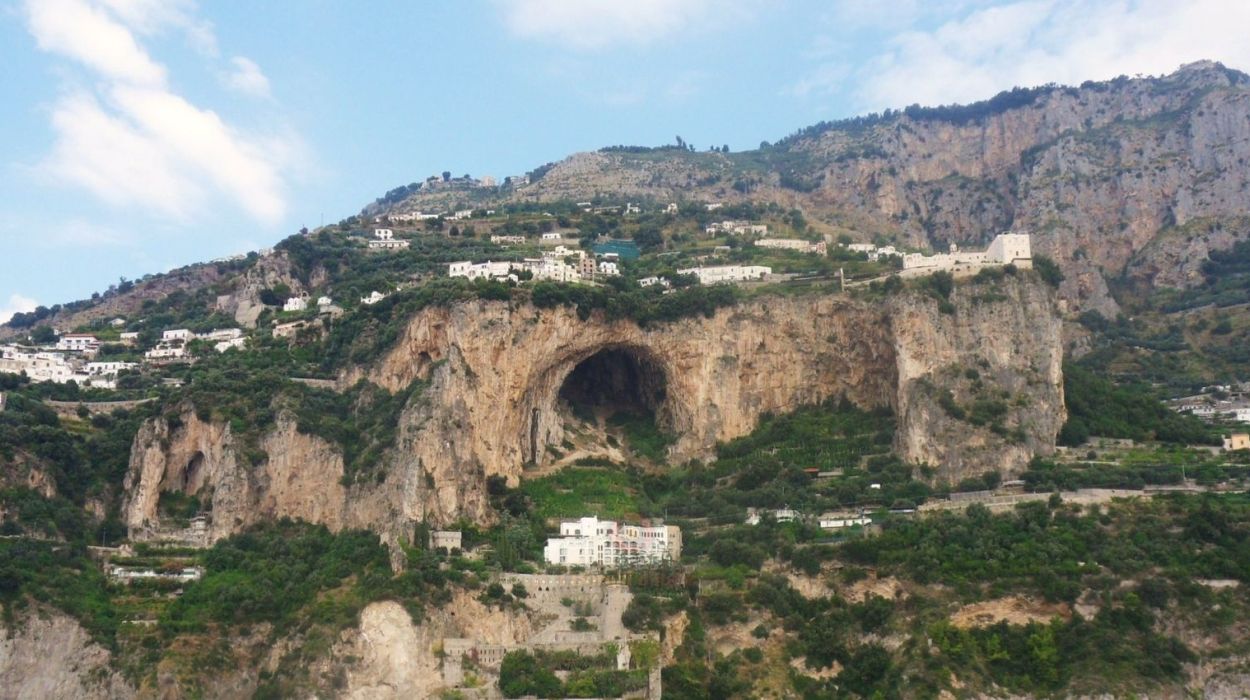
Il Borgo d’Italia
tutto da scoprire ed esplorare
Monumenti
Conca dei Marini: L’Eredità Monumentale Sospesa sul Blu
Conca dei Marini è un palcoscenico naturale dove i monumenti non sono semplici strutture, ma sentinelle millenarie che narrano la storia di marinai, monache e difese costiere. Ogni pietra, ogni scalino e ogni volta affacciata sul mare è un pezzo di storia che merita di essere onorato.
Il Monastero Santa Rosa: Dove Storia e Lusso Si Fondono
Eretto nel 1681 su uno sperone roccioso a picco sul Tirreno, l’ex Conservatorio di Santa Rosa da Lima è il monumento più iconico e trasformativo del borgo.
- L’Architettura: Il complesso, un tempo dimora di monache domenicane, conserva l’austera bellezza del Seicento, con giardini terrazzati a strapiombo sul golfo.
- Il Legame Culturale: Questo luogo è la culla della celebre Sfogliatella Santa Rosa, il cui involucro a forma di cappuccio monacale e il ripieno goloso sono nati proprio tra queste mura sacre. Oggi, magnificamente restaurato come resort di lusso, il Monastero testimonia come la storia possa evolvere in un’esperienza di ospitalità di livello mondiale.
La Torre Saracena: Il Baluardo di Capo di Conca
Sul promontorio di Capo di Conca, solitaria e maestosa, si erge la Torre Bianca, nota anche come Torre Saracena.
- Funzione Storica: Eretta tra il XIII e il XVI secolo, faceva parte del sistema di avvistamento e difesa voluto dai Viceré di Napoli per proteggere la Costiera dalle incursioni dei pirati e dei corsari.
- Visione Panoramica: La sua posizione strategica offre una vista impareggiabile che spazia dalla baia di Conca fino a intravedere l’isola di Capri, rappresentando un punto di osservazione privilegiato per comprendere l’antica vocazione marittima e difensiva del borgo.
La Chiesa di San Giovanni Battista: Il Tesoro di Maiolica
La principale chiesa parrocchiale è un gioiello di architettura sacra che domina l’abitato con il suo stile barocco.
- L’Impatto Visivo: Posta in una posizione panoramica invidiabile, è rinomata per il suo campanile a cuspide, che si innalza con eleganza ed è rivestito di maioliche vietresi dai colori vivaci. Questo dettaglio cromatico la rende un punto di riferimento inconfondibile nel paesaggio.
- L’Arte Sacra: All’interno, tra le tre navate, si conservano pregevoli opere d’arte e testimonianze di devozione marinara, che ne sottolineano il ruolo di custode della fede e della tradizione locale.
La Grotta dello Smeraldo: Il Monumento della Natura 💚
Sebbene sia un’opera naturale, la Grotta dello Smeraldo è considerata un monumento per il suo impatto estetico e la sua unicità.
- L’Esperienza: Una cavità carsica parzialmente invasa dal mare, si trasforma in una suggestiva “cattedrale verde” quando la luce solare filtra attraverso una fenditura sottomarina, tingendo l’acqua di un incredibile color smeraldo.
Curiosità
Conca dei Marini: I Segreti Svelati della Perla Inossidabile
Conca dei Marini non è soltanto una cartolina, è un compendio di aneddoti esclusivi e meraviglie geologiche che ne cementano il mito. Oltre la sua celebre bellezza, questo borgo custodisce storie che ne rivelano l’anima unica.
1. Il Comune “Miniaturizzato” 🤏
Conca dei Marini detiene un singolare primato geografico che testimonia la sua esclusività: è, dopo Atrani, il secondo comune meno esteso della Campania. Questa dimensione ridotta non è un limite, ma una garanzia di intimità e riservatezza che ha attratto l’élite mondiale. Il borgo si sviluppa in verticale, con le sue famose scalinatelle che collegano il mare ai terrazzamenti, rendendolo un labirinto pittoresco lontano dal chiasso.
2. La Marina Amata dai VIP e il Mito della Tonnara
Prima di diventare il rifugio dei VIP, la Marina di Conca era il cuore pulsante dell’attività economica.
- L’Ultima Tonnara: Conca ospitò l’unica Tonnara dell’intera Costiera Amalfitana, un’attività di pesca del tonno che rimase in funzione fino alla metà del Novecento.
- Il Jet Set Anni ’60: Subito dopo la chiusura della Tonnara, la sua baia tranquilla e le strutture sulla spiaggia divennero il set naturale della Dolce Vita. Fu qui che Jacqueline Kennedy Onassis venne ospitata dalla famiglia D’Urso, contribuendo a lanciare il borgo come meta di lusso internazionale, apprezzata anche da figure come Gianni Agnelli e le Principesse d’Olanda e Inghilterra.
3. La Grotta dello Smeraldo: Un Teatro Subacqueo 🎭
La Grotta dello Smeraldo è un prodigio naturale con un tocco di devozione e leggenda.
- Scoperta Recente: A differenza di altre grotte note fin dall’antichità, quella di Conca fu scoperta solo nel 1932 da un pescatore locale, Vincenzo Di Palma, che ne scoprì casualmente la cavità.
- Il Presepe Sommerso: Sul suo fondale, a circa quattro metri di profondità, è collocato un suggestivo presepe subacqueo in ceramica bianca di Vietri sul Mare. Ogni anno, durante il periodo natalizio, questo presepe diventa il fulcro di una suggestiva processione subacquea, una tradizione unica che unisce fede e mare.
4. La Chiesa con il Campanile in Maiolica e il Belvedere
La Chiesa di San Giovanni Battista è un tesoro storico e panoramico. Edificata sulle rovine di un tempio pagano, vanta un elemento architettonico distintivo che cattura lo sguardo: il suo campanile termina con una volta a cuspide interamente rivestita di maioliche vietresi, tipiche della tradizione campana, offrendo un contrasto cromatico spettacolare tra il cielo e l’architettura sacra. Nelle vicinanze si trova anche il belvedere di Punta Vreca, il cui nome dialettale si traduce in “punta nave”, per la sua forma che ricorda una prua sul mare.
Personaggi
Le Figure Nativi e il Patrimonio Culturale
1. Jonathan Cilia Faro: Il Tenore e Chef Globale
Tra le figure contemporanee di rilievo e indubbiamente legate per nascita a Conca dei Marini spicca Jonathan Cilia Faro.
- Il Percorso Artistico: Riconosciuto come un Tenore di talento, Cilia Faro ha conquistato palcoscenici internazionali. La sua carriera artistica e la sua notorietà lo proiettano come uno dei nomi più illustri originari del piccolo borgo, portando il nome di Conca nel mondo.
2. L’Inventrice Anonima della Sfogliatella Santa Rosa
Il dolce simbolo della Campania, la Sfogliatella, ha qui la sua origine più nobile. Sebbene l’inventrice sia una figura anonima, la sua creazione è un patrimonio di inestimabile valore nato proprio in questo luogo.
- Il Lascito Culinario: La prima versione del celebre dolce, la Sfogliatella Santa Rosa, fu ideata nel Convento di Santa Rosa da Lima nel XVII secolo da una monaca di clausura. Questa figura, pur non avendo un nome noto, è un personaggio fondamentale nella storia gastronomica italiana. La sua invenzione rimane un’eredità culturale unica di Conca dei Marini.
Ricette Tipiche
La Sfogliatella Santa Rosa: Il Capolavoro Nobile
Se c’è una ricetta che definisce in modo assoluto l’identità di Conca dei Marini, questa è la Sfogliatella Santa Rosa. La sua fama è globale, ma la sua origine è inequivocabilmente locale.
- Storia Divina: Questo capolavoro dolciario nasce nel XVII secolo tra le mura del Monastero di Santa Rosa da Lima. Una suora di clausura, per non sprecare gli avanzi di semolino e ricotta, creò un guscio di pasta sfoglia, a forma di cappuccio di monaca, farcito con un ripieno ricco e cremoso.
- La Ricetta Originale: La Santa Rosa si distingue dalla più comune sfogliatella napoletana (riccia o frolla) per la sua inconfondibile guarnizione: dopo la cottura, viene decorata con crema pasticcera e amarene sciroppate. È un’esplosione di gusto che bilancia la croccantezza della sfoglia con la dolcezza vellutata del ripieno, un vero e proprio Prodotto Agroalimentare Tradizionale (P.A.T.) della Campania.
I Sapori Autentici della Tradizione Marinara
Conca dei Marini, come antico borgo di pescatori, celebra il suo legame con il Tirreno attraverso una cucina semplice ma intensa, basata sul pescato freschissimo della baia.
1. Tubetti con i Totani (o Tubetti al Ragù di Totani)
Questo è il vero piatto-simbolo della cucina di mare di Conca. Nato dalla necessità di usare il totano, una preda abbondante e saporita pescata localmente, questo primo è un inno alla semplicità.
- L’Essenza: I totani (calamari o seppie di piccole dimensioni) vengono tagliati e cucinati in un ragù leggero a base di pomodorini freschi (spesso i celebri pomodorini del piennolo o del Vesuvio), aglio e olio extra vergine d’oliva. La pasta usata sono i tubetti (o “tubettini”), ideali per raccogliere il sugo denso e saporito. Il risultato è un piatto che racchiude il profumo del mare in un boccone confortante.
2. Pescato Fresco “All’Acqua Pazza”
In Costiera Amalfitana, il modo migliore per esaltare la freschezza del pesce è il metodo dell’acqua pazza. A Conca, questo trattamento è riservato al pescato del giorno (spigole, orate o pezzogne).
- Il Metodo: Il pesce viene cotto in un brodo semplice e aromatico composto da acqua di mare (o acqua dolce con sale), un filo d’olio, aglio, prezzemolo e i famosi pomodorini del territorio. Questa tecnica permette di mantenere la carne tenera e succosa, impregnandola dei sapori basilari e freschi della dieta mediterranea.
3. La Frittura di Paranza
Nei ristoranti affacciati su Marina di Conca, la frittura di paranza è un must-have. Si tratta di una frittura mista di pesce minuto e crostacei pescati in giornata con le reti a strascico (la “paranza”).
- Degustazione Pura: Veloce, croccante e leggera, la frittura è servita in carta paglia con una spruzzata di limone sfusato amalfitano, il cui aroma intenso aggiunge una nota agrumata indispensabile per esaltare il sapore delicato del pesce.
Questi piatti rappresentano il cuore gastronomico di Conca dei Marini: un equilibrio perfetto tra il sacro e il profano, tra il glamour dei frequentatori celebri e l’umiltà delle sue radici marinare.
